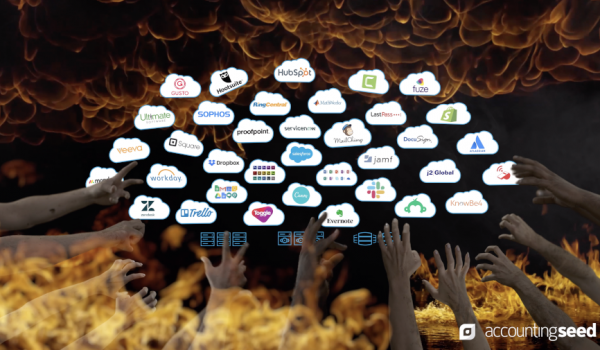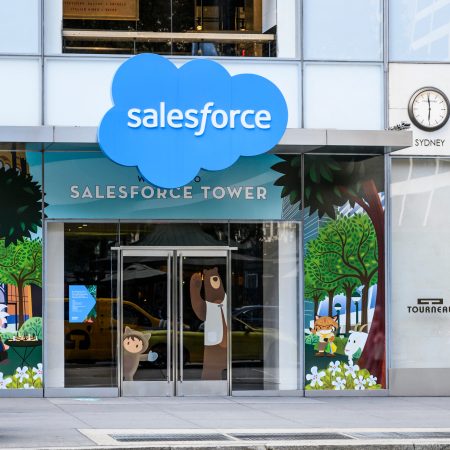
Author: Tony Zorc, CEO & Founder of Accounting Seed
Software needs for businesses are constantly growing, particularly as new technologies are developed and companies seek to leverage new tools to power their growth. But when is it too much? As IT departments change and adapt to growing technology trends the biggest issue isn’t just how many applications are being used, but if they are equipped to work together.
In the chaos of implementing the right business management software (traditionally including sales, operations, support, and accounting), there’s also the concern for connecting them effectively with the other tools within the company’s management system. More often than not, companies find themselves in what we like to call, Integration Hell. Fortunately, there are 4 easy ways to avoid Integration Hell completely.
When Apps Attack: What’s Happening to IT Departments?
More and more companies are shifting to cloud-based software for their speed, access, and utility. These applications are delivered by developers as software as a service (SAAS). Because they are delivered via the cloud, many companies now have little-to-no in-house networks and have very little network costs. Therefore, IT departments are shrinking (or being eliminated) because the individual software companies can manage the technology on their end for the customer if issues occur. This is a double-edged sword in a world saturated with so many apps.
The reality is that companies often rely on too many siloed applications and these applications cannot work together. The true value of an IT system is when the various software used can streamline processes by easily communicating between programs and relaying key data.
With siloed applications in the business management space, all the IT costs and performance come down to how well the 10, 20, 30 + apps talk to each other. This is when companies must resort to integrations to connect these disparate solutions. Companies then get overwhelmed when all these apps don’t work together because of the volume and poor quality of the integrations used. Welcome to the gates of Integration Hell.
Check out our free accounting system integration guide
How Do Companies Land in Integration Hell?
Corporate software is typically bought via committees, sometimes formed around individual departments. The danger here is when they only focus on the feature set, meaning what the product does. While focusing on the product’s features is important, what’s overlooked is how the technology will function with the rest of the IT ecosystem.
Integration is usually ignored or misunderstood, derailing the process of connecting mission-critical solutions. This causes processes to fail or data to be misaligned throughout the information system. Instead of freeing up staff’s time, the lack of, or poorly developed, integration will force them to do more work to compensate for the lack of connectivity. It also doesn’t help when software companies deliver fragile connectors that are prone to dysfunctions or outright failure.
Traditional Integrations are expensive to write and maintain. Maintain being the main point of emphasis here. When integrations are implemented for siloed apps, the integration usually must undergo periodic maintenance to keep it working. Many software companies actually outsource integration development and don’t maintain the integration themselves, so this also complicates the vitality of the connection. Whenever software is updated or upgraded, the integration must also be adjusted to avoid disruptions.
Middleware is used by integrators to establish and maintain the connections between the desired software. However, providers often overstate the bandwidth of the technology and ease of setup. Even with maintenance, dysfunctions can persist. All of this drains the company’s time and money, while not delivering the functionality needed.
Integration Matters
Integrations should really be among the core criteria for choosing software, not a side consideration. Today, integration is one of the main performance indicators for software. Nobody wants to have to re-enter, check, and laboriously track down information. Businesses want and need apps to work together so their staff can focus on bigger priorities. Integration is what lets software perform efficiently and in a focused manner to eliminate unnecessary work and enable consistent data throughout the management system.
It’s true that there’s a lot to think about with software and integration, but there are solutions that won’t lead to Integration Hell. One of them is to not rely on traditional, multi-platform integration altogether.
Check out our free accounting system integration guide
4 Ways to Avoid Integration Hell
To really maximize your company’s IT, you need to see past single applications and consider the importance of having a connected management system. Instead of managing a ton of apps, focus on using just a few flexible, robust applications that can seemly connect with each other on a single management platform. Let’s look at how you can avoid Integration Hell:
- Consolidate apps on a single platform.
Using an IT platform like Salesforce provides you with multiple flexible, scalable solutions in the form of native apps. Leveraging a comprehensive system like the Salesforce CRM, you have access to all the software you need, from point-of-sale to accounting software. Because these apps are built on the same platform, they are inherently designed to communicate to each other. The need for expensive, traditional integration is eliminated. Instead, your data is shared easily and securely on a single platform, allowing you to manage your whole operation in a single space. - Define what other apps the new software needs to talk to.
There are times when integration can’t be avoided. Typically this is due to previous technology investments that absolutely require it. You’ll need to work with your team to document actions, triggers, responses, and other requirements you want from the software in relation to the other apps you’re using. If your apps aren’t designed to work together this can be a challenge. Consult with trusted integration specialists to make sure the systems are connected properly. - Work with IT professionals.
It’s crucial that you work with IT consultants to map out and understand your integration requirements. If you don’t have in-house IT personnel, contract with an outside professional to get clear, unbiased feedback and insight. IT professionals also need to be part of the buying process to analyze integration specifics, as well as API to assess the best options for smooth data flow. Remember, with technology, you’re investing for the long run, a little money spent here is a lot of money saved in the long run. This will pay off in an effective management system that enhances your business’ performance. - Balance specific features with integration needs.
Make sure to choose a product that has both the key features you need and can be customized to work with your other software. Even with great features, if the software can’t sync with your other programs or has a weak API will just create more work and errors for you in the long run. Your biggest return on investment will be a flexible product that can be smoothly integrated your platform and can be configured and customized around your growing needs. Again, management platforms with native applications are the best options here.
Your company’s salvation from Integration Hell will not just save you a lot of headaches and money, but also streamline your entire operation. With a connected information system, you can pivot to create more automation and enhance your customers’ experience. No more worrying about integration or connection issues. Instead of managing a ton of siloed apps, using a management platform lets you consolidate your software to focus on simply running your business.
See Accounting Seed in action
Get a close-up view of how accounting on Salesforce can eliminate the need for costly integrations—and silos of mismatched information—by sharing the same database as your CRM.



